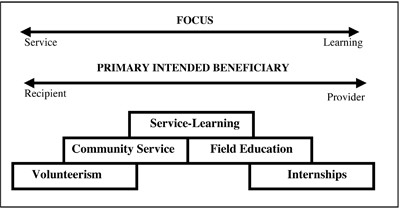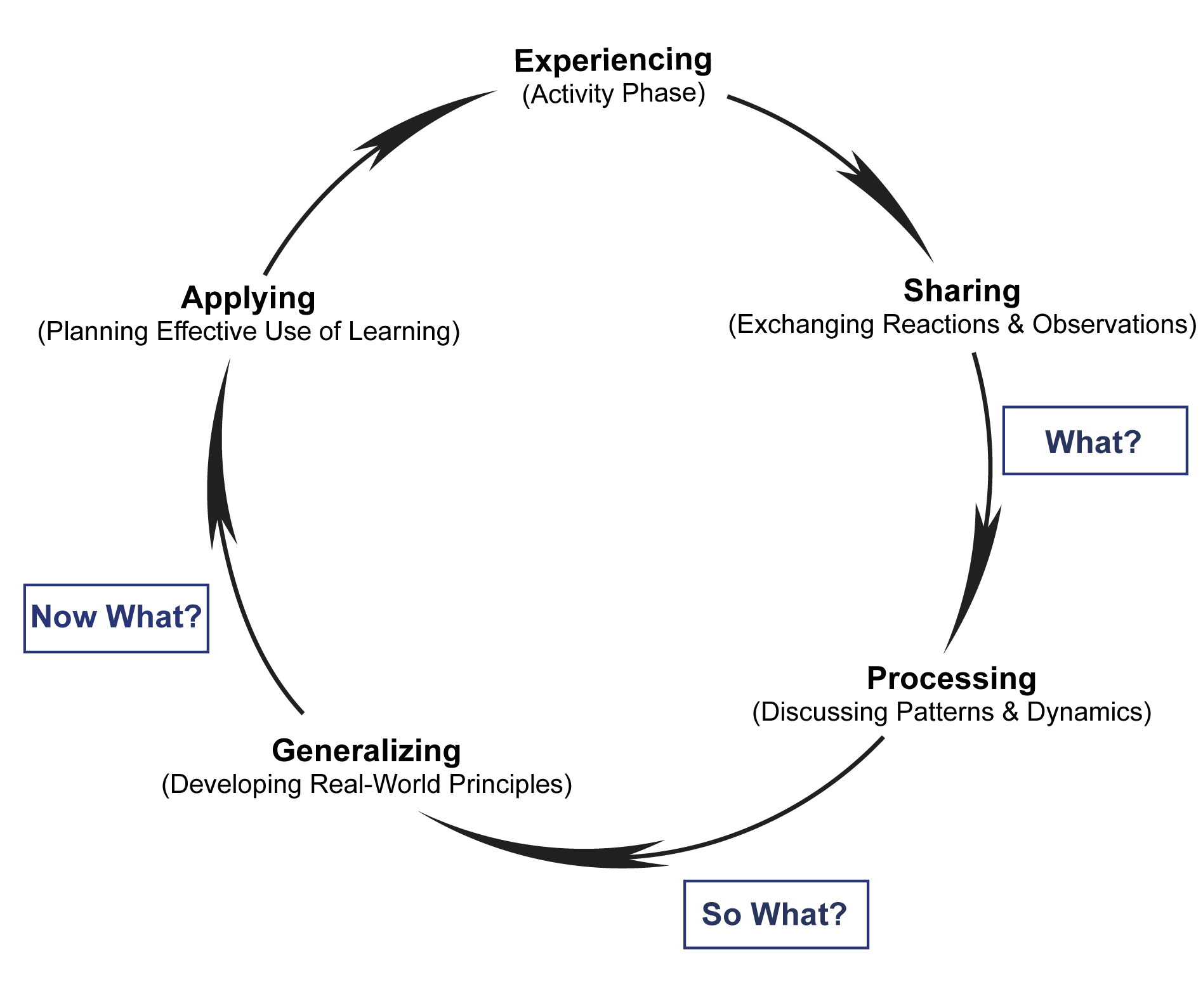Capstone Experience: Experience(s) which link and integrate learning in the major with prior learning as well as with the world of work.
Community Partners: Individuals within community agencies that work with students and faculty in service learning projects. (This term can also refer to the actual agency or organization.)
Cooperative Education: Students are paid to work with an employer, usually for two or more semesters and sometimes can receive academic credit.
Engagement: Broad term which encompasses varied ways to create university/community partnerships.
Experiential Learning: “Learning by doing” rather than through rote or didactic sharing. Teachers are seen as facilitiators not experts. Example activities include: cooperative education placements, internships, classroom-based hands on activities as well as service learning. Several Models of Experiential Learning have been developed. One often-used 4-stage model, developed by David Kolb, helps us think about the pedagogy of service learning in communication. Still, note the importance of Reflection in the majority of these models!
Internship: Semester long work experience related to a student’s field of study. Can be paid or unpaid, but typically students plan to receive academic credit.
Reflection: Thinking back and communicating about select aspects of the service experience with the purpose of integrating learning. Reflections can be done before, during, and/or after the community experience. Many educators would not consider a project service learning unless there was some reflection!
Service Learning (SL): A specific form of both engagement and experiential learning. The focus is on having students meet academic objectives through community-based activities.
Volunteering: Voluntarily giving time, energy, and capabilities to a community agency without pay. Is typically NOT linked to course objectives or followed up by student reflections.
Service Learning: A Balanced Approach to Experiential Education

Chart by Andrew Furco, included in a presentation given at ECU’s Service Learning Conference in Spring 2006.
Service Learning, as shown above, incorporates community engagement (i.e. Service) while simultaneously addressing academic course objectives (i.e. Learning). Some experts say that service projects “added on” to an existing course may not adequately accomplish pedagogical objectives. Others think service projects added to an existing course can be valuable. Regardless of your take on that, do think carefully about the learning goals for your course as well as the Five Criteria for a Service Learning course while planning your projects.
The above diagram also depicts the relational/partnership nature of service learning: the focus is on needs of the community partner (i.e. Agency/Provider) AND their constituents (i.e. Recipients or people actually served). Students and faculty NEED to work with the Community Partner while developing, revising, and finishing any project to meet the real needs of the agency. In service learning isn’t appropriate for the class to develop a communication product for the Community Partner without input from that partner; rather, teamwork helps make a difference for the agency and the students!
Pedagogical Benefits of Service Learning for Students
“Service-learning is a credit bearing, educational, experience in which students participate in an organized service activity that meets identified community needs and reflect on the service activity in such a way as to gain further understanding of course content, a broader appreciation of the discipline, and an enhanced sense of civic responsibility.” Bringle and Hatcher, 1995
“I read and I forget, I see and I remember, I do and I understand.”
quote attributed to Confucious.
In short, Service Learning helps promote student learning through:
- Active participation in service experiences;
- Structured time for thinking, discussing and writing about their service experience (i.e. Reflections);
- An opportunity to use skills and knowledge in real-life situations;
- Extending learning into the community; and
fostering a sense of caring for others.
- Service-learning also:
- Builds effective collaborative partnerships between colleges and other institutions and organizations.
- Engages other adults in supporting student learning
- Meets community needs
- Provides engaging, productive opportunities for young people to work with others in their community
[Adapted from Learn and Serve America]
What Some of the Research Tells Us
SL Positively Effects Student’s Personal Outcomes:
- Self efficacy, identity, spiritual growth, and sometimes moral development
- Interpersonal development, leadership and communication skills
SL Positively Effects Social Outcomes:
- Reduces stereotypes and facilitates cultural, racial understanding
- Promotes sense of social responsibility and citizenship
- Positive commitment to service and involvement in community service after graduation
SL Positively Effects Learning Outcomes:
- Impacts academic learning
- Improves ability to apply learning in “real world”
- Demonstrates complexity of understanding, problem analysis, critical thinking, cognitive development
SL Contributes to Career Development
SL Positively Impacts the Students’ Relationship with the University:
- Builds stronger faculty relationships
- Improves student satisfaction with college
- Increases likelihood of college graduation
[Adapted from Eyler, Giles, Stenson, and Gray (2001), At a Glance]
Student Benefits From Community-Based Learning: from the University of Minnesota’s Community Involvement and Service-Learning available at: http://www.servicelearning.umn.edu/faculty/guidesl.html
Reflection, a core component for service learning, provides the means for integrating the service into course or curricular learning goals. In other words, reflection informs LEARNING!
“Structured opportunities for reflection can enable learners to examine and form their beliefs, values, opinions, assumptions, judgments and practices related to an action or experience, gain a deeper understanding of them and construct their own meaning and significance for future actions (Moon, 1999).”
Moon, J. Reflection in Learning and Professional Development . London : Kogan Page Limited, Stylus Publishing Inc, 1999.
Hatcher and Bringle "believe that effective reflection activities (a) link experience to learning objectives, (b) are guided, (c) occur regularly, (d) allow feedback and assessment, and (e) include the clarification of values" (157). Hatcher, Julie and Robert Bringle. "Reflection in Service Learning: Making Meaning of Experience," Educational Horizons (1999): 179-185.
As used in the service learning context, “reflection” combines:
- Critical thinking about key questions (such as What? So What? Now What?) with
- Communicating those thoughts in writing, speaking or through multiple channels.
Reflection then, helps students make sense of what they are seeing and doing so they can learn something new from the experience.
Developing Strategies for Student Reflections
Four key words to keep in mind when designing student reflections are: continuous, connected, challenging, contextualized (4 C’s by Eyler and Giles, 1999). Usually these are done in connection with classroom time, but the Community Partner could be encouraged to help students do reflections as well.
Continuous: Theory about reflection points to a continuous process-before, during and after- the SL experience. This coincides with the different phases of the Experiential Learning Cycle.
Figure 1. Continuous Reflection and the Experiential Learning Cycle

Kolb illustrates the process of reflection in the Experiential Learning Cycle (Figure 1). The process begins with a defining and sharing of the “What?” of the student's experience and follows a continuous cycle towards “So What?” and “Now What?”. Answers to the what, so what and now what questions are tied together to form a comprehensive and integrated discovery and learning cycle for the student throughout the duration of a service-learning experience (Eyler 1999).
[Adapted from http://www.servicelearning.org/instant_info/fact_
sheets/he_facts/he_reflection/]
Connected: Service experiences are directly linked to the learning objectives and promote synthesizing of actions and thought. (You are encouraged to add specific SL objectives to your syllabus.) For more information visit How-to do Service Learning.
Challenging: Learning involves “a stretch” for the student. A deeper critical-thinking level is encouraged by thought-provoking strategies initiated by the faculty member. This necessitates a comfortable, safe classroom environment to freely express new ideas, opinions, ideas and feelings.
Contextualized: Reflections correspond to the course content, topics and experience in a meaningful way.
Methods for Reflection
Possibilities for Course Reflections span both traditional classroom communication tools and newer technology. A “laundry list” of Reflection possibilities is listed below (Here’s a great place you’re your own pedagogical creativity!)
- Written Reflections (Paper)
- Journals or Learning Logs
- Reflective Essays
- Research Papers
- Newspaper Article
- Newsletter Article
- Guide for Future Participants
- Written evaluations
- Written Reflections (Online)
In addition to the above which could be adapted for the online
classroom:- Discussion Threads
- Blogs
- Online Journal
- Speaking Reflections
- One-one conference with faculty
- Class/Group discussions
- Oral Reports to group or class
- Public speaking about project
- Teaching material to others
- Visual or Multimedia Reflctions
- Photographs with captions
- Scrapbook
- Paintings, drawings, collages
- Webpages
- Powerpoint presentations
- Video presentations
- Games and simulations
- And more…
Other Resources on Reflection
Additional Ideas for Reflection/ Questions to Pose for Reflection are available from the ECU Volunteer and SL Center and also at:
http://servicelearning.org/instant_info/links_collection/index.php?popup_id=357
Easy-to-Use Information about New Technology:
http://www.techsoup.org/toolkits/web2/#content
Concise Guide to Reflection (Reflection and Multiple Intelligences):
A Concise Guide to Reflection.doc
Source: Youth Service California found at www.yscal.org